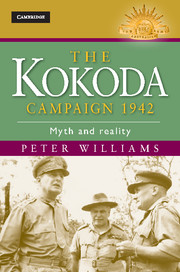Book contents
- Frontmatter
- Contents
- Photographs
- Maps
- Tables
- Key to military symbols
- Acknowledgements
- Note on the text
- Glossary
- Chapter 1 Introduction
- Chapter 2 Strategy
- Chapter 3 Military intelligence
- Chapter 4 The Nankai Shitai
- Chapter 5 From the landing to Deniki
- Chapter 6 Isurava
- Chapter 7 Guadalcanal and Milne Bay
- Chapter 8 The Japanese build-up
- Chapter 9 First Eora–Templeton’s
- Chapter 10 Efogi
- Chapter 11 Ioribaiwa
- Chapter 12 Japanese Artillery
- Chapter 13 Malaria and dysentery
- Chapter 14 The Japanese supply crisis
- Chapter 15 Second Eora–Templeton’s
- Chapter 16 Oivi–Gorari
- Chapter 17 The war in the air
- Chapter 18 Conclusion
- Note on sources
- Notes
- Bibliography
- Index
Chapter 9 - First Eora–Templeton’s
Published online by Cambridge University Press: 05 November 2013
- Frontmatter
- Contents
- Photographs
- Maps
- Tables
- Key to military symbols
- Acknowledgements
- Note on the text
- Glossary
- Chapter 1 Introduction
- Chapter 2 Strategy
- Chapter 3 Military intelligence
- Chapter 4 The Nankai Shitai
- Chapter 5 From the landing to Deniki
- Chapter 6 Isurava
- Chapter 7 Guadalcanal and Milne Bay
- Chapter 8 The Japanese build-up
- Chapter 9 First Eora–Templeton’s
- Chapter 10 Efogi
- Chapter 11 Ioribaiwa
- Chapter 12 Japanese Artillery
- Chapter 13 Malaria and dysentery
- Chapter 14 The Japanese supply crisis
- Chapter 15 Second Eora–Templeton’s
- Chapter 16 Oivi–Gorari
- Chapter 17 The war in the air
- Chapter 18 Conclusion
- Note on sources
- Notes
- Bibliography
- Index
Summary
Dr Vernon wrote in his diary that the fighting in early September near Eora village ‘seems to have been one of the major clashes in the retreat yet was largely passed over in silence in the Australian press’. The five days of fighting rates a few lines in the Japanese official history, the Senshi Sosho, and a page in the Australian official history. In part this is because First Eora follows hard upon Isurava and is obscured by it, the Japanese referring to it as Second Isurava.
Weakened by Isurava, the Japanese 144th Regiment was rested while 41st Regiment pursued the defeated Australians. The problem was that 41st Regiment was incomplete. The decision to postpone until November the advance on Port Moresby resulted in a change in shipping priorities. Japanese infantry were no longer urgently required in Papua so part of of 41st Regiment was delayed while more labourers and bridging specialists were sent to improve the Giruwa–Kokoda supply line. The regiment had also lost 710 men to form a new temporary supply unit. As a consequence, the whole of 41st Regiment was not assembled until it defended Oivi in early November 1942. Before November, the only elements of the regiment that did any fighting on the Kokoda Track were the headquarters, the gun company, the 2/41st and 12th Company of 3/41st Battalion. When the 1/41st, the delayed battalion, finally arrived in September, it advanced to Nauro and on arrival was ordered to return to Kokoda. The 3rd Battalion’s commander, Lieutenant-Colonel Tomita Yoshinobu, was responsible for the defence of Giruwa and for the eastern of the two supply echelons to Kokoda. His battalion did not leave the coast until it marched to fight at Oivi in November.
- Type
- Chapter
- Information
- The Kokoda Campaign 1942Myth and Reality, pp. 109 - 120Publisher: Cambridge University PressPrint publication year: 2012



